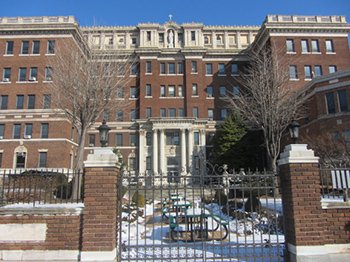Mercy Hospitals Embrace Energy Efficiency in Philadelphia
 PHILADELPHIA — Three Mercy Health System hospitals are using energy-efficient methods that have helped the city of Philadelphia make the EPA’s list of the top 10 U.S. metropolitan areas with the most Energy Star–certified buildings in 2013.
PHILADELPHIA — Three Mercy Health System hospitals are using energy-efficient methods that have helped the city of Philadelphia make the EPA’s list of the top 10 U.S. metropolitan areas with the most Energy Star–certified buildings in 2013.
Operating since 1918, Mercy Philadelphia Hospital’s exterior looks antiquated. But inside, the hospital has updated and replaced various pieces of equipment in recent years with newer, more efficient models. This has helped reduce its total kilowatt hour (kWh) consumption from 10,177,401 kWh in 2012 to 9,859,048 kWh in 2013 — a reduction of 318,353 kWh and a dollar savings of about $20,000.
Mercy Fitzgerald Hospital programmed HVAC equipment throughout the hospital to shut down at various times during the evening and retrofitted approximately 9,500 light fixtures with more energy-efficient ones. It also installed light sensors, timers, photo light controls and motion sensors throughout the hospital.
Nazareth Hospital replaced 700-ton chillers with energy-efficient units, modernized the hospital’s energy management system and retrofitted 274 bathroom fixtures with low-flow, energy-conserving units.
“I just became this energy nut so I’ve been looking for ways throughout the hospital to reduce costs and save on energy bills,” said Mercy Philadelphia Director of Plant Operations Jerry Moyer. “Over the years, I got really into it, and I became an Energy Star partner with the EPA.”
Moyer said the hospital has been using Energy Star’s Portfolio Manager to measure and track energy and water use of the facility. In addition to the Portfolio Manager, properties can go a step further to benchmark their energy use relative to similar buildings nationwide. “We’ve been scoring 100 the last three years,” Moyer said.
Last year, the city of Philadelphia started requiring all buildings with a certain number of floors to have an Energy Star rating, which was exciting, Moyer said, because Mercy had already started doing that. For him, it was simply a matter of first looking at what was already happening in the hospital that could be changed.
For example, one energy-efficient change to the operations was an adjustment on the regulators that supply steam to the building. The hospital was previously running 90 pounds of high-pressure steam for air-heating coils. As equipment was getting more efficient, it wasn’t necessary to run that much, and the hospital cut back to 90 pounds of steam. The hospital’s gas provider was baffled how the facility could end up paying almost $300,000 less for its utility bill versus previous years.
For Mercy, a commitment to sustainability is more than improving its utilities. Moyer believes the entire staff has helped to reinforce the commitment to be an EPA Energy Star partner. The hospital has embraced a campaign called Turn It Off, Turn It Off, Turn It Off, a pledge that is renewed every Earth Day on April 22.
“We have signage everywhere [for the program],” Moyer said. “It’s on the steps, it’s on the building, it’s all over the place to let the hospital staff, visitors and patients know what we’re doing. On Earth Day, we have a booth set up for energy-savings ideas —anything from LED lights to CFL lighting and timers [for lights].”
One of the biggest challenges Moyer thought he would face in pursuing energy efficiency within the Mercy Health System was getting support from senior management. But that wasn’t the case.
“For other facilities out there that I talk to, the biggest problem is trying to get senior management to buy into [an energy program] because now you’re going into capital — do you have the money to put in for it? It takes time, but you have no choice; it’s something you have to do.”
